Search the Special Collections and Archives Portal
Search Results
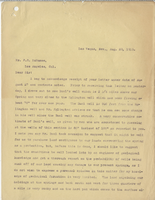
Letter from Walter R. Bracken (Las Vegas) to F. R. McNamee (Los Angeles), August 29, 1913
Date
Archival Collection
Description
Bracken reporting his visit to Buol's well and recommending a report from an engineer before the Las Vegas Land and Water Company purchases any additional land to protect their water rights.
Text
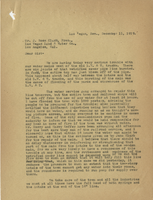
Letter from Walter R. Bracken (Las Vegas) to J. Ross Clark (Los Angeles), December 11, 1919
Date
Archival Collection
Description
Bracken flooded the town with posters warning residents that in order to repair a burst pipeline from the springs to the town, water service, including that for fire protection, would be off for 24 hours.
Text

Letter from C. W. McKee (Las Vegas) to J. P. Mack (Los Angeles), March 3, 1927
Date
Archival Collection
Description
Measurements of the output of the Las Vegas springs and well. Letter is signed McFee, but that is a typo and should read McKee.
Text

Letter from Walter R. Bracken (Las Vegas) to F. H. Knickerbocker (Los Angeles), May 21, 1927
Date
Archival Collection
Description
Discussion of running a pipeline from the small spring to the reservoir supplying water to Las Vegas.
Text

Report on projected cost of water at Las Vegas for year 1930, February 4, 1930
Date
Archival Collection
Description
Summary of the cost of water for the railroad and the water company in Las Vegas in 1930
Text
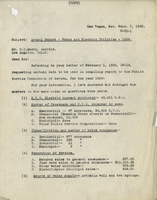
Letter from Walter R. Bracken (Las Vegas) to C. C. Barry (Los Angeles), February 7, 1930
Date
Archival Collection
Description
Response for request for information needed to report to the Nevada Public Service Commission regarding electricity used and details of water users and sales in 1929.
Text
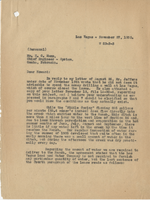
Letter from Walter R. Bracken (Las Vegas) to Howard C. Mann (Omaha), November 27, 1935
Date
Archival Collection
Description
Letter from Bracken explaining the water situation on the Las Vegas Ranch to the chief engineer of the Union Pacific system.
Text
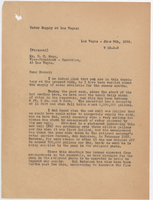
Letter from Walter R. Bracken (Las Vegas) to H. C. Mann (Las Vegas) regarding Las Vegas water supply, June 9, 1938
Date
Archival Collection
Description
Las Vegas was just entering the hottest part of the year and well No. 1 had dropped off production considerably.
Text

Letter from Walter R. Bracken (Las Vegas) to Roscoe Moss (Los Angeles), June 10, 1938
Date
Archival Collection
Description
Well No. 2 had dropped production from 2.5 million gallons a day to 700,000 gallons, and Bracken discussed possible remedies.
Text

Letter from the Las Vegas Chamber of Commerce to W. H. Comstock, A. S. Halstead, W. R. Bracken, and J. Ross Clark, August 13, 1919
Date
Archival Collection
Description
Letter stating that low water pressure had been a serious problem during the last three fires in Las Vegas and should be fixed. If irrigation was the culprit, then the city commission should enact watering restrictions.
Text
